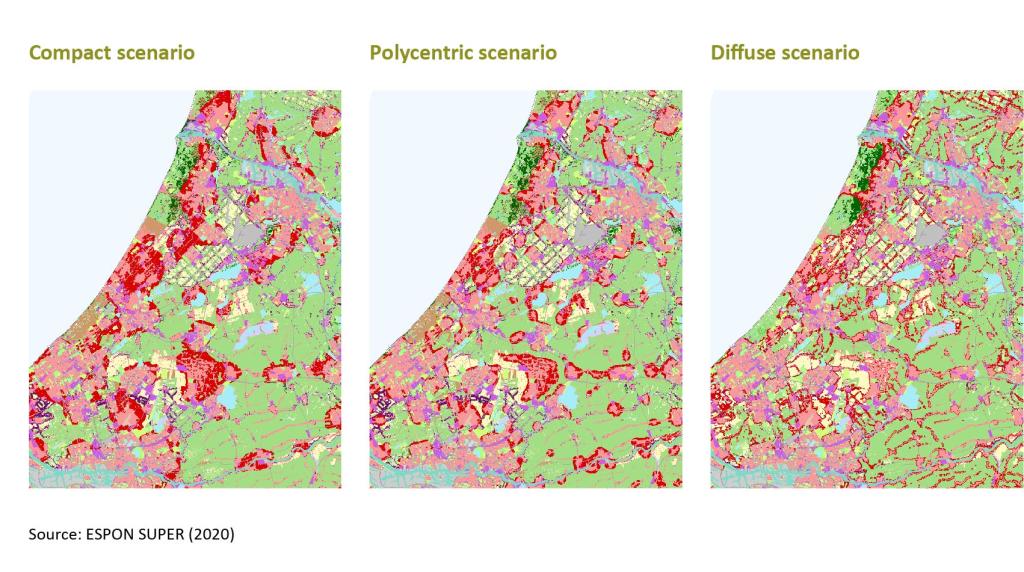
A choice for 2050: The Netherlands more compact, more polycentric, or more diffuse?
The new National Environment and Planning Strategy (NOVI) has identified a great housing shortage in the coming decades. It urges that new homes be built at locations within the existing urban structure or near transport nodes. At the same time, various parties are arguing that the housing demand cannot be accommodated in these kinds of locations, and low-density greenfield development is necessary and desirable. The ESPON project Sustainable Urbanization and land-use Practices in European Regions (SUPER) drew up three scenarios which illustrate the advantages and disadvantages of divergent urbanization choices. The application of the LUISETTA land-use allocation model shows what land would be sacrificed for urban use in 2050 in each scenario, whereas the SUPER sustainability assessment reveals potential impacts and trade-offs. Whatever choice is made, it will have an irreversible impact on the urban structure of the Netherlands.
Urbanization is a choice
There are those who argue – usually implicitly – that socioeconomic drivers, such as household development and economic growth, create pressure for urban development and then uncritically assume that this pressure will cause an equivalent expansion of urban land. This is obviously not the case. Natural barriers such as water bodies or mountains obviously affect the form, direction and density of urban development (Kostof, 1991). Terrain matters. The same is true for human interventions such as the provision of infrastructure or the siting of governmental institutions, schools, hospitals, and the like. Urban development is moreover the product of conscious decisions to encourage or discourage building at certain locations (e.g. protected natural areas, environmental zoning around industry, subsidies for brownfield regeneration). Policy matters.
When we look at urbanization in the Netherlands, we can identify differences in settlement structure based on soil type and readily observe how the advent of land reclamation techniques radically transformed the rural landscape. As we pointed out in our previous post (Evers & Van Schie, 2019), Dutch spatial planning is esteemed, rightfully or not (Needham, 1989), for guiding urban development to new towns, growth centres and compact edge-of-town neighbourhoods, and away from the Green Heart, National Buffer Zones and the National Nature Network.
Policy scenarios
At present, the National Environment and Planning Strategy (NOVI), which has sustainability as its main theme, is nearing implementation (Ministerie BzK, 2020). This document identifies a large housing shortage and asserts that new homes should be built at suitable locations. But what does this mean exactly? Given the policy text, there is a lot of room for interpretation with respect to the desired urban form (Van Vliet, 2020). Among other things the NOVI has stated that it wishes: (1) compact and preferably infill (re)development, (2) multimodal-oriented development and (3) swift development of high-quality and affordable housing. These criteria roughly correspond to the three pan-European scenarios generated within the ESPON SUPER project on sustainable urbanization: (1) compact, (2) polycentric and (3) diffuse. Although the NOVI prefers compact to polycentric development and clearly eschews the diffuse option, the latter is certainly within the scope of the societal debate where various parties argue that low-density greenfield development is necessary for delivering the needed housing in a timely fashion.
Each SUPER scenario contains a storyline up to 2050 explaining how identical drivers (demography, economy, climate change) were interpreted within differing societal attitudes on housing preferences, mobility, government intervention and the like, resulting divergent policy packages for urbanization (Evers, 2020). This input was then used to run a pan-European land-use model called LUISETTA to simulate which areas would be urbanized by 2050 in each scenario1. Afterwards, the sustainability of the model output was gauged according to the academic literature on the advantages and disadvantages of each urbanization type. Given their similarity to the criteria provided in the NOVI, these scenarios can contribute to the discussion in the Netherlands on the implications of fundamental policy choices on urbanization preferences.

- Compact: development is concentrated in and near large cities; 50% infill target.
- Polycentric: development concentrated in and near small towns; 30% infill target.
- Diffuse: development occurs piecemeal on existing roadways; no infill target.
1 Some caveats should be borne in mind when interpreting the model output. For the sake of distinctiveness, the scenarios are purposefully extreme and lack territorial differentiation: the entirety of Europe applied the same policy package regardless of the local context. Moreover, no consideration was made for interim decision-making: the same philosophy was carried through to 2050 even though we know that political vicissitudes are endemic. Finally, the suitability of locations for conversion to urban use was largely endogenous to the model, generally favouring existing urban edges and road infrastructure. In the end, the maps produced at the European level cannot be taken as forecasts displaying probable urban development. Instead, they but should be understood as visual representations of possible futures to support a policy debate on the desirability of the three choices.
The Netherlands in 2050
Above we can see the model output for the western part of the Netherlands. The net amount of new urbanization, shown in dark red, is roughly equal in the compact and polycentric scenarios, and slightly larger in diffuse (about +12%). Because it was run at the European level, the model ignores much existing policy, as evidenced by the UNESCO area ‘the Beemster’ being urbanized, especially in the diffuse scenario. Still, it does provide food for thought for the NOVI regarding which locations are more suitable than others for accommodating homes and jobs. For example, would it make sense to allow the area around Heerhugowaard to expand into a regional centre such as in the Diffuse scenario? Despite the likely longer commutes (assuming many will travel to Amsterdam for work) and car-oriented morphology, precious land at the edges of Amsterdam is kept intact in this scenario. Which is more important: mobility or green infrastructure? A similar point was recently made with respect to plans for new residential development in Almere to the northeast of Amsterdam, as jobs have mainly grown to the southwest of Amsterdam near Schiphol Airport (Van den Boomen, 2021). But building homes where the jobs are can restrict future airport expansion, and arguably, international accessibility. At this point, the NOVI does not provide much guidance for resolving such spatial dilemmas.
When looking at the Polycentric versus the Compact scenarios other spatial trade-offs become manifest. Is it preferable to build at the edges of major cities or midsize towns (Pols et al., 2018)? The former may occur at higher densities and might be easier to connect to municipal transit services and cycling, but the latter may just give the push needed to realize a suburban light rail line. In addition, there seems to be a spatial trade-off at a larger geographical scale: Compact shows more development along the coast whereas in Polycentric more homes are built in the Green Heart. Again, the NOVI is not very specific about its preferences in this regard. A broad debate on the advantages and disadvantages of these scenarios could help hone decision-making about which sites are most suitable for urbanization.
The SUPER project provides support in this regard as well. As said, the NOVI strives for sustainable development. This is manifestly evident in its choice of themes as well as in its handling of the urbanization criteria. As we saw, the model output provides clear indications of the types of areas that would be ‘sacrificed’ for urban use, but there are many other ways to score these scenarios on sustainability. To this end, the SUPER project drew up an assessment framework using the customary broad conceptualization of sustainability (economic, ecological, and social). To make this framework, scientific literature was reviewed on the impact of different urban forms on various indicators that fall within the three sustainability dimensions, and the impact scored using best judgement from very negative (- -) to very positive (++). A full description is provided in Annex 4 of the SUPER project (Evers et al., 2020).
As is evident from the table below, the SUPER scenarios score quite differently on different dimensions, revealing trade-offs between and within dimensions. In addition, it demonstrates that compact development is not always more sustainable, as often assumed. Moreover, many indicators show nuanced or mixed results: sometimes the academic literature is conflicted, inconclusive, or show opposite kinds of impacts in different contexts. Territory matters. For this reason, Dutch policymakers will need a more sophisticated analysis than the SUPER project can provide. An analysis that takes the specific spatial, administrative and policy aspects on board in the scenario design as well as the sustainability assessment. Such a study is now underway.
| Compact | Polycentric | Diffuse | |
|---|---|---|---|
| Economic sustainability | |||
| GDP, wealth | +/- | ++ | + |
| Public finance | + + | + | - |
| Jobs | ++ | ++ | +/- |
| Accessibility | +/- | ++ | +/- |
| Business areas | ++ | ++ | +/- |
| Housing demand | - | + | + |
| Transportation costs | +/- | + | -- |
| Energy consumption | + | + | -- |
| Ecological sustainability | |||
| Reducing mobility (by car) | ++ | ++ | -- |
| Reducing pollution, including CO2 | ++ | + | -- |
| Green urban areas | - | + | -/+ |
| Biodiversity | +/- | +/- | - |
| Land consumption | + | + | -- |
| Natural hazards | - | + | +/- |
| Climate change | +/- | + | +/- |
| Consumption of resources | +/- | + | - |
| Renewable energy | +/- | +/- | +/- |
| Space for future water retention | + | + | + |
| Circular economy | + | + | - |
| Social sustainability | |||
| Health | +/- | +/- | +/- |
| Affordable housing | +/- | +/- | ++ |
| Equity/inclusion | +/- | + | -- |
| Public and recreational space | +/- | + | +/- |
| Variety (high-rise, suburban, etc.) | + | + | + |
| Mixed-use areas | + | ++ | - |
| Satisfaction with home environment | +/- | + | + |
Towards a sustainable future in the Netherlands
The Netherlands Environmental Assessment Agency is preparing a foresight study on spatial and environmental development that, in parts, is closely aligned to the philosophy of the pan-European ESPON SUPER project (PBL, te verschijnen). By narrowing the focus to the Netherlands, this study is able to perform more plausible and detailed analyses of policy decisions and take current land-use plans into account. As an initial exercise, it created three scenarios which bear a remarkable similarity to those in the SUPER project: (1) dichtbij [close by resembles Compact], (2) verbonden [connected resembles Polycentric] and (3) ruim [spacious resembles Diffuse]. All three scenarios, however, were tailored to the Dutch context.
- Close by goes a step further than compact by concentrating virtually all development in existing urban areas. This was not possible in the SUPER project as the LUISETTA model did not allow for densification or brownfield redevelopment.
- Connected concentrates development near public transport hubs. This was also not technically possible in the LUISETTA model, although this was the original idea behind the scenario.
- Spacious simulates typical suburban development by favouring urbanization at large low-density locations on the urban fringe instead of piecemeal along roadways as in Diffuse.
Benefitting from higher resolution data, extensive information about existing policy restrictions, plans in the pipeline and demographic prognoses, this study can offer Dutch policymakers a more solid and more reliable foundation regarding the consequences of policy decisions. Moreover, the model is flexible enough to allow tailor-made options to be assessed as well. As a result, the research can be considered a tool for evaluating ex-ante the effects of prioritizing one urbanization goal over another.
Back to the NOVI
2050 seems far, far away. But the decisions we make today determine tomorrow’s world. If we are to believe its powerful first chapter outlining its vision, the NOVI wishes to make some of these strategic decisions. Nevertheless, it leaves out most of the important details about exactly where and how to develop and is conspicuously silent about the inherent dilemmas. The SUPER project explored some of these with respect to sites (model output) as well as sustainability dimensions, and the PBL is carrying this further in its upcoming study. Urban planning and design strive to create synergy or win-win situations. Ultimately however, land-use decisions usually benefit some parties over others, requiring careful considerations of the trade-offs and deliberate and bold decision-making. It is to be hoped that, building on evidence from PBL and others, the NOVI’s urbanization policy will become less ambiguous as it reaches implementation.
References
- Evers, D. (2020). ESPON SUPER Final Report—Main report. ESPON.
- Evers, D., Katurić, I., Van der Wouden, R., Van Schie, M., & Van Rijn, F. (2020). ESPON SUPER Final Report Annex 4—Sustainability assessment and scenarios. ESPON.
- Evers, D., & Van Schie, M. (2019, October 16). Putting Dutch ‘urban sprawl’ in a European perspective [Text]. PBL Planbureau Voor de Leefomgeving. https://www.pbl.nl/en/blogs/putting-dutch-urban-sprawl-in-a-european-pe…
- Kostof, S. (1991). The City Shaped. Thames and Hudson.
- Ministerie BzK. (2020). Nationale Omgevingsvisie (NOVI) Hoofddocument.pdf. Ministerie van Binnenlandse Zaken.
- Needham, B. (1989). ‘Strategic Planning and the Shape of the Netherlands through Foreign Eyes: But do Appearances Deceive?’ Built Environment Vol. 15, 1, 11–16.
- PBL. (te verschijnen). Grote opgaven in een beperkte ruimte. Ruimtelijke keuzes voor een toekomstbestendig leefomgevingsbeleid. Planbureau voor de Leefomgeving.
- Pols, L., Bijlsma, L., Breedijk, M., & Van Schie, M. (2018). Stadsranden: Schakelzones tussen stad en land. Planbureau voor de Leefomgeving.
- Van den Boomen, T. (2021, January 8). Amsterdam komt ruimte voor woningen tekort. Kan het groeien rondom Schiphol? NRC.
- Van Vliet, M. (2020). Kan de Nationale Omgevingsvisie bouwen op de huidige woningbouwpraktijken? [MA]. University of Amsterdam.

